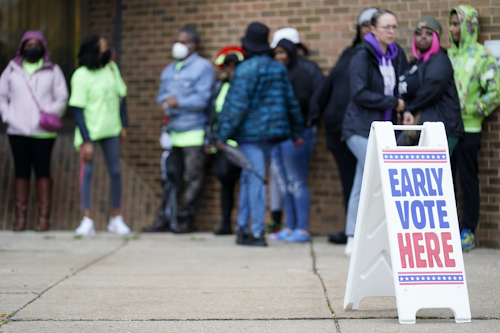Memo
Published November 7, 2022
3 minute read
Election Eve: Democrats who Deliver will be those seen as Mainstream

Unlike Republicans, Democrats largely fended off intra-party primary challenges from the extremes.
- The NewDem Action Fund had a 77% success rate with its endorsed candidates in primaries. Moderates like Haley Stevens (MI11), Shontel Brown (OH11), Dina Titus (NV01) and Sean Patrick Maloney (NY17) who were targeted by the far left overcame those internecine attacks.
- Candidates endorsed by Sanders-style Our Revolution and AOC-style Justice Dems lost more than they won, with primary win rates about half that of New Dems (37% and 43% respectively).
- By contrast, the Republican primaries consistently favored the most extreme candidates, with Trump’s endorsements carrying the day in 21 of 26 races. According to The New York Times, 70% of Republican candidates for Congress have questioned the legitimacy of the 2020 election, and 8 of 10 Republicans who supported impeachment are now unemployed.
Yet mainstream Democratic candidates were still pummeled by attacks linking them to unpopular positions of the far left.
- From Labor Day to late October, Republicans spent $115 million on crime and immigration ads in the top eight U.S. Senate races, compared to Democrats’ $33 million.
- Third Way’s analysis of ad expenditure data from AdImpact showed the GOP spent $36 million in Wisconsin, $25 million in Pennsylvania, $19 million in Arizona, $12 million in Georgia, and $8 million in Nevada tormenting Senate Democratic candidates saying they want to “Defund the Police,” “[set] accused criminals free into the community before trial,” “[surrender] the border,” and are “dangerously liberal” on crime.
- Public safety and crime were mentioned in 45% of GOP Senate ads in the final weeks of the campaign—becoming the top-mentioned issue above the economy and inflation—and rose to nearly 40% of GOP ad mentions in all federal races.
The Democratic brand is seriously damaged and a major liability in swing districts and states.
- When asked to map themselves and the parties on an ideological scale, voters put themselves closer to Republicans than Democrats—as do swing voters.
- Only 43% of voters say Democrats share their values; the same proportion say the party values hard work. Less than half (46%) describe Democrats as patriotic.
- A majority of voters (55%) describe Democrats as preachy and too extreme, and 59% say the party has gotten more extreme in recent years.
Candidates who survive a red wave will do so because they distanced themselves from the damaged brand and pushed back against the far left.
- Our moderate candidates are our only saving grace. When asked which party has nominated more extreme candidates this cycle, voters chose Republicans by a seven-point margin (44%-37%). Among swing voters, that margin was twenty points.
- Despite misgivings about the party, voters gave Democratic Senate candidates a favorability rating of 45%, compared to 37% for Republicans. 27% of swing voters rate their Democratic Senate candidate favorably, while only 13% say the same about their Republican candidate.
- New Dems delivered the gavel to Nancy Pelosi in 2018 and were the only ideological caucus to flip seats (3) from red to blue in 2020. They are likely to repeat that performance in 2022 as the only caucus to deliver new seats to Democrats in a tough cycle. Justice Dems and Our Revolution have continued their record of ZERO flipped districts since their formation. It’s now three cycles in a row they have failed to contribute to a Dem majority.
Subscribe
Get updates whenever new content is added. We'll never share your email with anyone.
